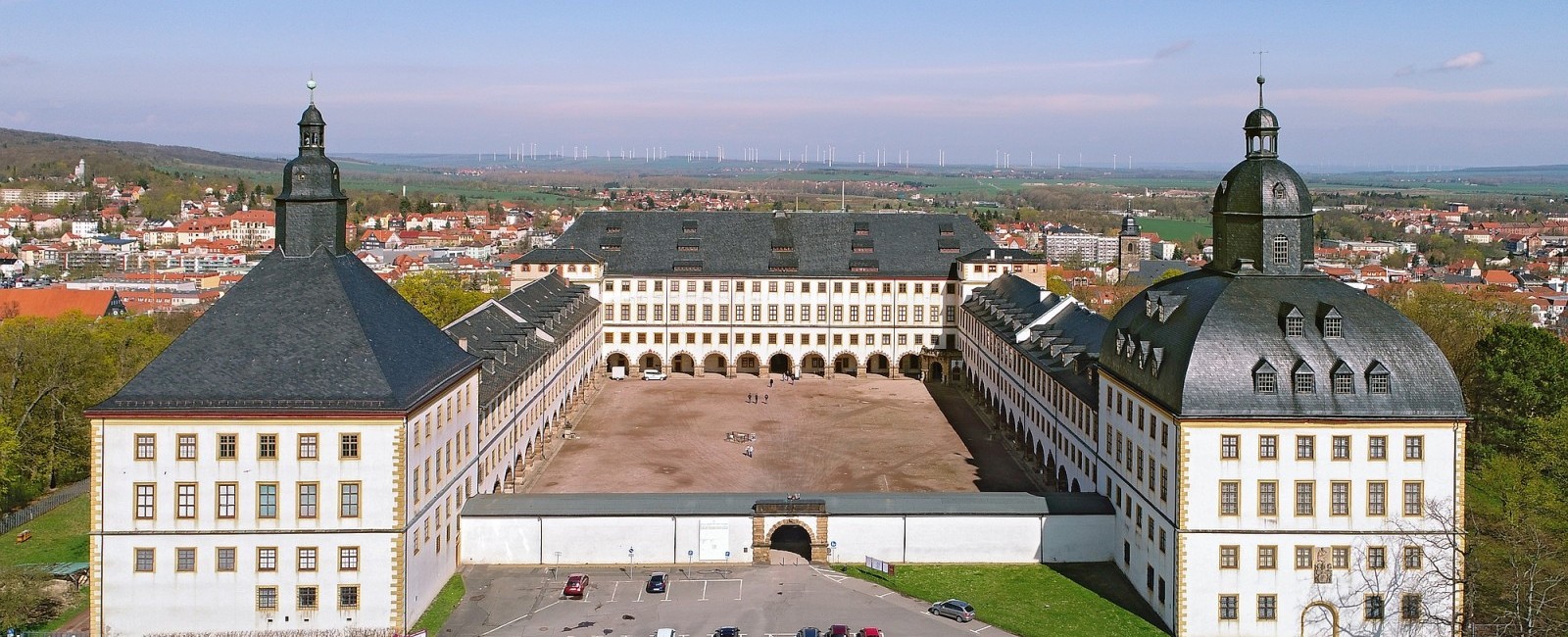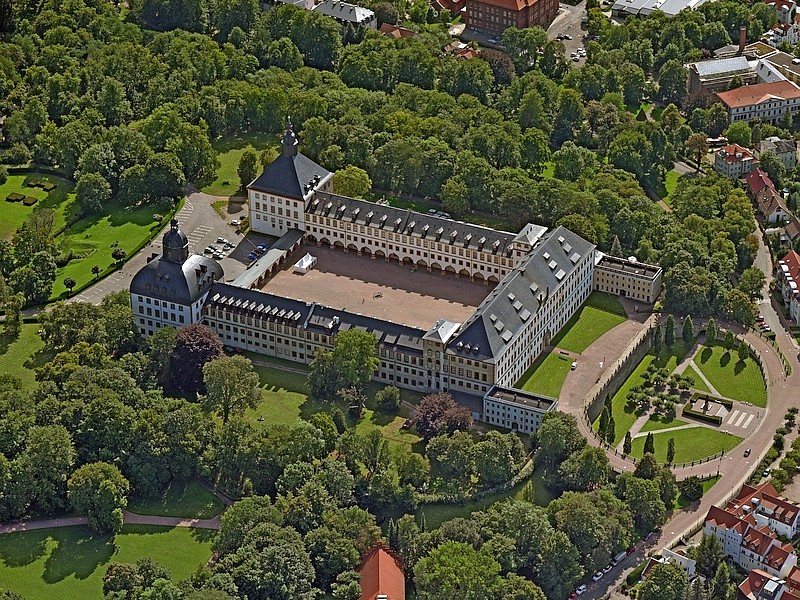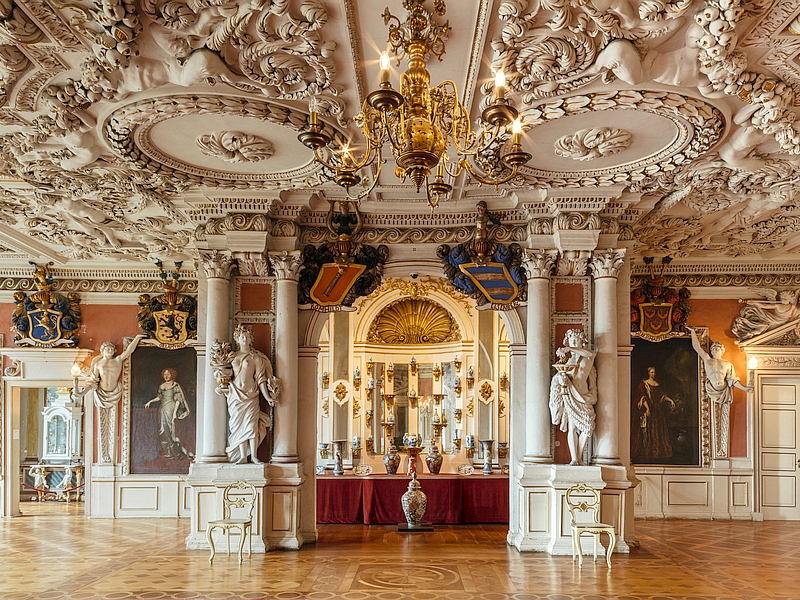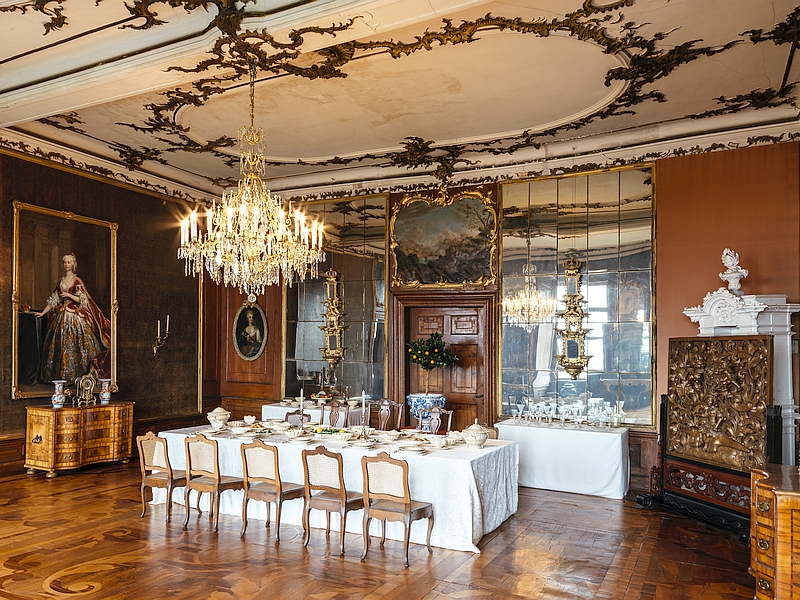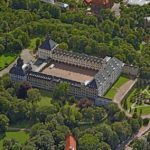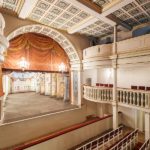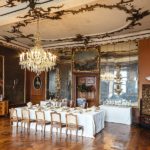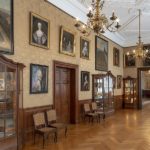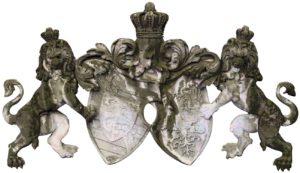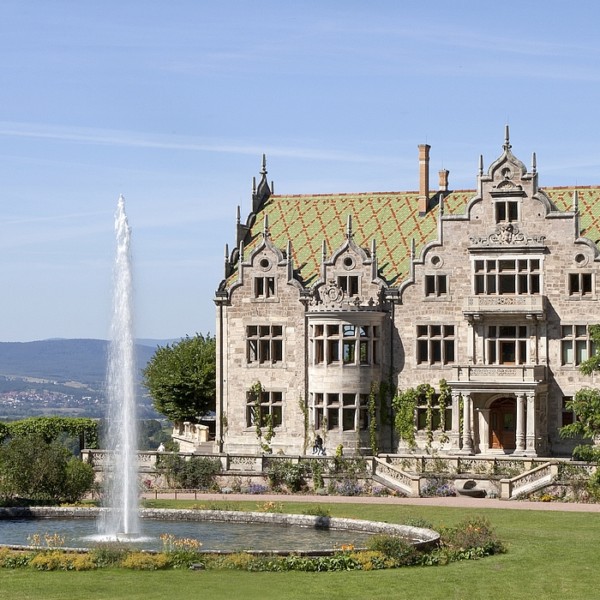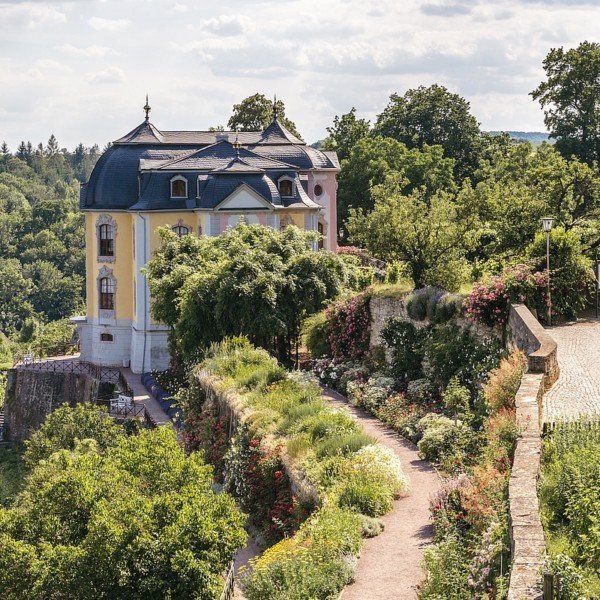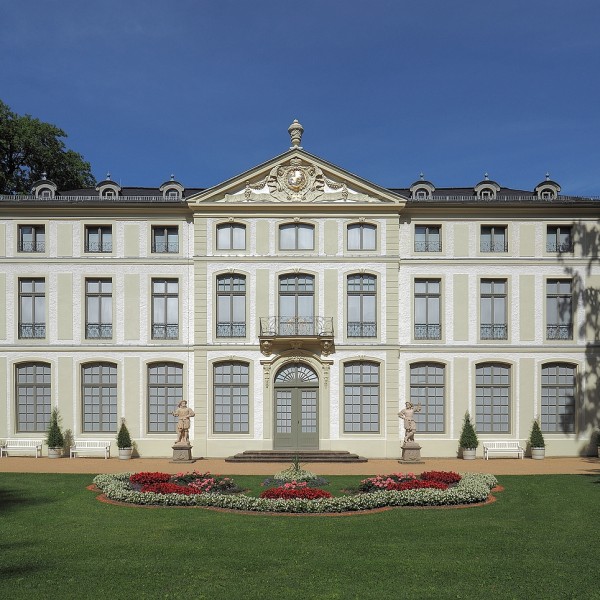Finder
Friedenstein Palace and Park
the largest palace in Thuringia
Residence of the dukes of Sachsen-Gotha, erected between 1643 and 1654, originally as four-wing complex, at the site of former Grimmenstein Castle, Ekhof theatre, orangery and landscape park from the 18th cent., Ducal Museum
The monumental complex measuring 140 x 110 metres is not only the largest palace in Thuringia, it was also one of the most remarkable buildings of the 17th century in the entire German Empire. There was hardly another prince at that time who as building sponsor owned a comparable residence. A sign of the duke’s honesty was that he commissioned a report named “Moral Scruples” (now kept in the archive) which was intended to give – and actually gave – him support for this enormous building project, which in times of war was probably not undisputed. Before visitors enter the palace courtyard with its 54 arches and its cycle of coats of arms, a statue of Duke Ernst I cast in bronze in 1904 welcomes them on the town-side of the palace where a fountain can also be found. Although the duke is supposed to have been a devout and strict Christian even when he was a young prince, he was not called “der Fromme” (the Pious) because of his devotion to God – the slightly mocking title “Bet-Ernst” (praying Ernst) which was occasionally heard made reference to that characteristic. Instead the word “fromm” in those days was a collective term for decency, leading a morally unequivocal life, courage, justice, honesty, thrift and correct behaviour towards members of the lower and higher ranks. The foundation stone for the two- and three-storeyed palace after designs by Caspar Vogel was laid in autumn 1643; less than three years later while building works continued the princely family and their household moved into the north wing which had been completed first. In 1656 the spacious four-wing complex built on a 332-metre-high plateau was completed (the single-storey south wing framed by two pavilion-like towers and used as a riding-hall only existed until the end of the 18th century). Work on the original interiors continued for another ten years; later generations had them altered several times by famous artists and craftsmen according to the prevailing tastes. Inside the palace, which is looked after by the Palace, Castle and Gardens Trust of Thuringia since 2004, the throne room with its lavish stucco decoration, the ducal audience chambers and studies, the museum of regional history, the palace museum with its collections (some of them famous) of paintings, drawings, china, coins and ethnology, and finally the cartographical museum are well worth a visit. In the west tower is a baroque theatre named after the “father of German dramatic art”, Konrad Ekhof (1720-78), and still in use. In the east tower, destroyed by fire in 1677 and afterwards rebuilt with a different roof, the pillar hall from 1687 with its original library furnishings can be visited. It is part of the research and State library belonging to the university of Erfurt. Apart from a cleverly thought-out, 2.5 kilometres-long system of underground allures it is no longer recognisable that at the time when Friedenstein Palace replaced Grimmenstein fortification it was still surrounded by large-scale military and fortified buildings.
The duchy of Sachsen-Gotha was created in the middle of the Thirty Years War (1618-48). During his reign (1640-74) Duke Ernst I, called the Pious, established a state which was exemplary at the time. The palace commissioned by him was built in about 13 years and its name – “Friedenstein” (stone of peace) – was deliberately significant. A dedicational inscription above the main portal on the palace’s town-side and a cartouche relief above showing the “kiss of peace” surrounded by the aphorism “Friede ernehret – Unfriede verzehret” (peace nourishes – strife destroys) also bear witness to the duke’s attitude.
Im Inneren des Schlosses haben sich Räume aus Barock, Rokoko, Klassizismus und Historismus erhalten. Heute befinden sich hier das Schlossmuseum, mit dem reich stuckierten Festsaal und den herzoglichen Appartements, sowie der Kunstkammer, das Museum der Natur und Historisches Museum. Die einmaligen Kunstsammlungen können im Herzoglichen Museum gegenüber besichtigt werden. Im Westturm befindet sich das Ekhof-Theater – ein Barocktheater, das den Namen Conrad Ekhofs (1720-1778) trägt. Er galt als „Vater der deutschen Schauspielkunst“ und Leiter eines der ersten durchgängig bespielten Theaters mit festangestellten Schauspielern. Aufgrund seiner originalen hölzernen Bühnentechnik gilt das Theater als eines der am vollständigsten erhaltenen des 17. Jahrhunderts und wird bis heute bespielt.
Since 1772 large parts of the fortification were pulled down, which helped gain space for the laying out of gardens. The first documented garden was the so-called Schlosswallgarten in front of the east side of the palace. Presumably it disappeared in 1772 when the fortifications were demolished. One of Friedenstein’s oldest gardens to have been preserved is the orangery garden which was created as of 1747 east of the palace. Under Prince Ernst II, who took up his office in 1772, the palace gardens gained a new quality. Full of inspirations after his journey to England the prince gave instructions to lay out an English garden with a long pond in the middle. On the grounds of the former kitchen garden the museum of natural sciences was erected in 1864. The grounds north and south of the drive towards the palace, which were only laid out in the 20th century, were remodelled several times. The parks and gardens around Friedenstein Palace bear witness to various periods of garden design, and in their complexity they are unique in Thuringia.
Der Orangeriegarten dagegen wurde meisterhaft in den Boden vertieft und bekam auf diese Weise die Anmutung eines Amphitheaters mit Blick zum Schloss Friedrichsthal. Flankiert wird der Garten von zwei Orangeriegebäuden sowie im Norden von einem Treibhaus. Das südliche Pendant wurde im Zweiten Weltkrieg zerstört.
Ausstattungsmerkmale










Mehr Informationen im Friedenstein-Blog
Die auf 15 Jahre angelegte Sanierung von Schloss und Park wird vom Bund und dem Freistaat Thüringen mit 60 Millionen Euro gefördert. Hier berichten die Stiftung Thüringer Schlösser und Gärten, die Stiftung Schloss Friedenstein Gotha und die Forschungsbibliothek Gotha gemeinsam rund um Schloss und Baugeschehen.
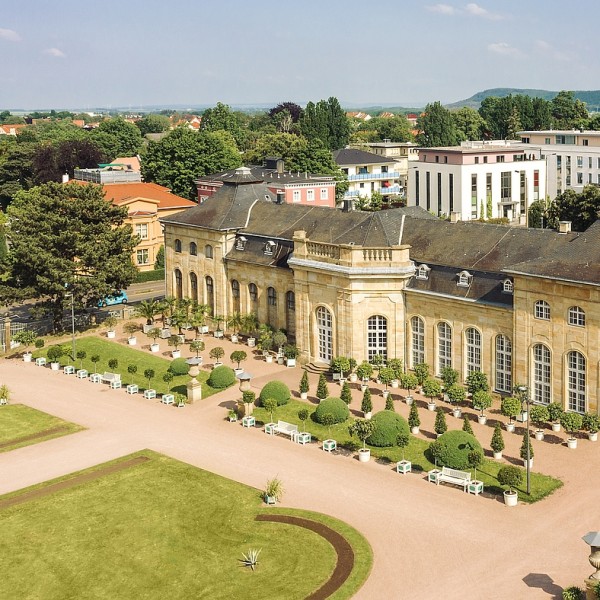
Schlossmuseum mit Kunstkammer, Museum der Natur und Historisches Museum, Herzogliches Museum
Montag und Dienstag geschlossen (ausgenommen Feiertage)
Mittwoch bis Sonntag geöffnet
Nov-März: 10:00 -16:00 Uhr
April-Okt: 10:00 -17:00 Uhr
24.12. und 31.12. geschlossen
parks and gardens
Parkanlagen frei zugänglich
Weitere Einrichtungen
Schlosskirche: im Rahmen von Gottesdiensten und Veranstaltungen | Kasematten: tägliche Führungen
Schlossmuseum mit Kunstkammer, Museum der Natur und Historisches Museum, Herzogliches Museum
99867 Gotha
Schlossverwaltung Schloss Friedenstein
99867 Gotha
Parkverwaltung
99867 Gotha
Fördervereine
Freundeskreis Kunstsammlungen Schloss Friedenstein Gotha e.V. T: 0 36 21/40 59 35 „Orangerie-Freunde“ Gotha e.V. T: 0 36 21/51 29 334 Museumslöwen – Gemeinschaft zur Förderung des Museums der Natur Gotha e.V. T: 0 36 21/82 34-690 Freundeskreis der Forschungsbibliothek Gotha e.V. T: 0 36 21/30 80 24
Museumsführungen Schlosskirche: Anfragen Öffnungen/Gruppenführungen
Einzelkarte „Friedenstein-Karte“ (inkl. Schlossmuseum, Historisches Museum, Museum der Natur, Ekhof-Theater, Sonderausstellungen) 12,- €, Tageskarte (nkl. Schloss Friedenstein und Herzogliches Museum – gültig
bis zum folgenden Öffnungstag der Museen) 16,- € alle Preiskategorien
gebührenpflichtige Parkplätze an der Südseite des Schlosses und am Herzoglichen Museum (jeweils Zufahrt über Parkallee)
Gaststätte Pagenhaus T: 0 36 21/40 36 12
spezielle Angebote der Museumspädagogik können im Museum nachgefragt werden
Das Schloss Friedenstein ist innerhalb der Stadt Gotha für Autofahrer und Fußgänger ausgeschildert. PkW: Wenn Sie ein Navigationsgerät nutzen, dann geben Sie bitte: Schloss Friedenstein, Schlossplatz 1, Gotha ein. Bahn: vom Bahnhof ist es ca. 1 Kilometer Fußweg

